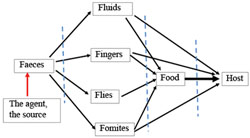18.2 Public health importance of waste management
How does waste management affect public health and the environment? Improper disposal of wastes, such as solid waste, human excreta and sewage, is one of the major risk factors that affect the health and comfort of individuals in rural Ethiopia where municipal or onsite facilities do not exist, or are not functional.
Name three diseases or pathogens that are transmitted in human waste.
There are many possible answers. You could have said diarrhoea, trachoma, amoebic dysentery, giardiasis, rotavirus, cholera, salmonellosis, shigellosis and other diarrhoeal diseases. In addition, you may have mentioned hookworm, roundworm, whipworm, tapeworms, schistosomiasis, filariasis, leptospirosis and many more. A very long list!
Poor waste handling and disposal can lead to environmental pollution, encourage the breeding of disease-vector insects, animal scavengers and rodents, and result in a range of diseases through different routes of exposure such as faeco-oral and soil transmitted mechanisms.
Figure 18.2 shows these routes of exposure diagrammatically; you may remember this diagram from Study Session 1. In this figure, you can see that faeces are the common source of contamination to the other ‘Fs’ – fluids, fingers, fomites and flies. These then contaminate our food and, consequently, a new susceptible human host.
Survey studies conducted in different parts of Ethiopia indicate that there are many highly prevalent faeco-orally transmitted intestinal parasites and other infectious agents (bacteria and viruses) in our environment. To break the transmission route of these disease agents, there needs to be total sanitation, which means prevention of any human contact with waste, i.e. no open defecation and the proper handling of solid waste. The broken lines in Figure 18.2 show the points at which a barrier or intervention can be made to prevent transmission. The first line of defence is to contain the faeces. The second is to protect the food from contamination and the third is to protect the potential host, the person who may become infected, from contaminated food, fingers, drinking water or other objects. To achieve total sanitation, the community needs to be involved in any plan to clean the local environment and must initiate its own waste disposal methods. You will learn some of the techniques that are used to encourage this sort of behavioural change in Study Session 21.
In addition to the dangers of disease transmission, health hazards associated with improper solid or liquid waste disposal include:
- Public or community nuisance due to foul odour and unsightliness of open defecation faecal matter and openly dumped solid wastes.
- Obstruction of drainage systems leading to creation of favourable conditions for disease vector breeding sites.
- Fire hazards.
- Psychological health hazards.
18.1.2 Solid waste

